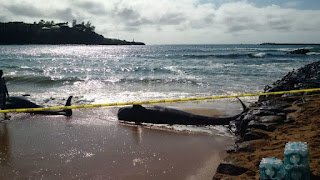(Image: Aerial view of Lehua Island, courtesy of DLNR.)
If you’re lonely, does looking in a mirror help? Probably not, but it may help for seabirds.
One of the tools wildlife biologists use for re-establishing
colonies of some seabirds is mirror boxes—structures with multiple mirrors, designed to convince the birds that
there are more of them than there really are.
That’s being attempted at Lehua Island, a small tuff cone
island off Ni’ihau, where biologists are trying to re-establish several bird
species that once nested there.
Those efforts have a chance of working, since rats
were declared eradicated from the island in 2021. Rats are believed to have
caused the failure of several nesting species on the island, since the rodents
eat both eggs and young birds.
Rat predation is significant: “rats (particularly black
rats; Rattus rattus) are considered to be a direct cause of the
threatened status of at least 75 island-nesting species of seabirds,” wrote the
authors of this paper. https://journals.plos.org/plosone/article?id=10.1371/journal.pone.0076138
But once the rats are gone, there is the question of how to
convince birds to start nesting in a location again. Mirrors are a solution for
some bird species.
The mirror technique is not new, and it seems to work.
Researchers in California, who were trying to re-establish a colony of common
murre found that once they arrived, the birds were far more dense around
mirrors than in other parts of the colony. They seem to like being in crowds.
At Lehua, mirror boxes are one of the techniques being used to try to lure three species of terns back to Lehua: the ʻewaʻewa or Sooty Tern, pākalakala or Gray-backed Tern, and the hinaokū or Blue-gray Noddy.
In addition to the mirror boxes, there are speakers broadcasting
recordings of tern songs, and decoy birds.
The state Department of Land and Natural Resources reported
on the efforts in this press release.
Researchers are using different techniques to try to attract
endangered ‘akē’akē or Band-rumped Storm-petrel and ʻuaʻu or Hawaiian petrels
to Lehua. For those species artificial nest boxes and recorded bird calls are
believed to be more effective.
All these birds are believed to be normally flying in
Hawaiian waters, but several may be nesting in colornies on Kaua’I, Ni’ihau and
elsewhere that are at risk from predation. Lehua is free of rats, cats, pigs,
dogs and most other predators, so it is considered a good spot for colony
re-estalbishment.
But it is not entirely predator-free. Researchers in 2019 published a paper that reported introduced barn owls are preying on seabirds
there and elsewhere.
Authors Andre Raine, Megan Vynne and Scott Driskill reported
on the impacts of barn owls at nesting sites on Kaua’i, Lehua and at the small
island Moku’ae’ae off Kīlauea Point.
The owls, which ironically were introduced to Hawai’i for
the purpose of controlling rats, tend to take adult nesting birds of numerous
species.
“Owl depredations were recorded of eight seabird species,
the most common of which were Wedge-tailed Shearwater Ardenna pacifica, Black
Noddy Anous minutus, and Bulwer’s Petrel Bulweria bulwerii.
Included were 21 depredations on federally listed Newell’s Shearwater Puffinus
newelli and Hawaiian Petrel Pterodroma sandwichensis,” they wrote.
While rats generally went after eggs and young, owls
generally take adult birds.
Their recommended solution:: “Barn Owl control should be
considered as an integral part of all Hawaiian seabird management programs.”
© Jan TenBruggencate 2023











